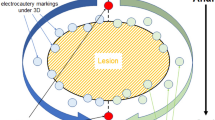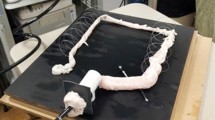Abstract
Background and objectives
Conventional endoscopy provides two-dimensional (2D) information without depth information. This study compared three-dimensional (3D) endoscopy and 2D endoscopy using an endoscopic submucosal dissection (ESD) training model to evaluate the utility of 3D endoscopy.
Methods
Porcine stomach specimens (7 × 7 cm) were prepared from commercially available resected porcine stomachs and a 10-mm hypothetical lesion was marked at the center of each specimen. Specimens were individually placed in an ESD training model, and subjected to either 2D or 3D ESD. En bloc resection rate, perforation rate, incision time, dissection time, and levels of five eyestrain symptoms (fatigue, pain, blurred vision, head-heaviness, and headache; 100-mm visual analog scale) were compared between the 2D and 3D procedures. In a crossover design, 8 endoscopists each performed two 2D and two 3D procedures.
Results
All 32 lesions were resected en block, but perforation occurred in one 2D procedure. Incision time was significantly shorter in 3D ESD than in 2D ESD (102.8 ± 42.1 s vs. 135.8 ± 65.7 s, p < 0.05). Dissection time was also significantly shorter in 3D ESD than in 2D ESD (366.3 ± 187.6 s vs. 517.8 ± 282.3 s, p < 0.05). Differences in levels of all symptoms except blurred vision between before and after ESD were larger in 3D ESD than in 2D ESD.
Conclusions
Incision time and dissection time were significantly shorter in 3D ESD compared with 2D ESD, but eyestrain was increased. Depth information from 3D images appears to facilitate rapid and stable ESD maneuvers.




Similar content being viewed by others
References
Sorensen SM, Savran MM, Konge L, Bjerrum F (2016) Three-dimensional versus two-dimensional vision in laparoscopy: a systematic review. Surg Endsc 30:11–23
Feng C, Rozenblit JW, Hamilton AJ (2010) A comuputerized assessment to compare the impact of standard, stereoscopic, and high-definition laparoscopic monitor displays on surgical technique. Surg Endosc 24:2743–2748
Tanagho YS, Andriole GL, Paradis AG, Madison KM, Sandhu GS, Varela JE, Benway BM (2012) 2D versus 3D visualization: impact on laparoscopic proficiency using the fundamentals of laparoscopic surgery skill set. J Laparoendosc Adv Surg Tech A 22:865–870
Nomura K, Kaise M, Kikuchi D, Iizuka T, Fukuma Y, Kuribayashi Y, Tanaka M, Toba T, Furuhata T, Yamashita S, Matsui A, Mitani T, Hoteya S (2016) Recognition accuracy using 3D endoscopic images for superficial gastrointestinal cancer: a crossover study. Gastroenterol Res Pract. https://doi.org/10.1155/2016/4561468
Nomura K, Kaise M, Kikuchi D, Toshiro I, Yumiko F, Yasutaka K, Masami T, Takahito T, Tsukasa F, Satoshi Y, Akira M, Toshifumi M, Shu H (2018) Recognition accuracy of tumor extent using a prototype 3D endoscope for superficial gastric tumor: an ex vivo crossover study. Endosc Int Open 6:E652–E658
Kikuchi D, Kaise M, Nomura K, Toba T, Kuribayashi Y, Tanaka M, Yamashita S, Furuhata T, Matsui A, Mitani T, Hoteya S, Iizuka T (2017) Feasibility study of the three-dimensional-flexible endoscope in endoscopic submucosal dissection: an ex vivo animal study. Digestion 95:237–241
Wagner OJ, Hagen M, Kurmann A, Horgan S, Candinas D, Vorburger SA (2012) Three-dimensional vision enhances task performance independently of the surgical method. Surg Endosc 26:2961–2968
Feng X, Morandi A, Boehne M, Imvised T, Ure BM, Kuebler JF, Lacher M (2015) 3-Dimensional (3D) laparoscopy improves operating time in small spaces without impact on hemodynamics and psychomental stress parameters of the surgeon. Surg Endosc 29:1231–1239
Alaraimi B, El Bakbak W, Sarker S, Makkiyah S, Al-Marzouq A, Goriparthi R, Bouhelal A, Quan V, Patel B (2014) A randomized prospective study comparing acquisition of laparoscopic skills in three-dimensional (3D) versus two-dimensional (2D) laparoscopy. World J Surg 38:2746–2752
Usta TA, Ozkaynak A, Kovalak E, Ergul E, Naki MM, Kaya E (2015) An assessment of the new generation three-dimensional high definition laparoscopic vision system on surgical skills: a randomized prospective study. Surg Endosc 29:2305–2313
Hanna GB, Shimi SM, Cuschieri A (1998) Randomised study of influence of two-dimensional versus three-dimensional imaging on performance of laparoscopic cholecystectomy. Lancet 351:248–251
Mueller MD, Camartin C, Dreher E, Hänggi W (1999) Three-dimensional laparoscopy. Gadget or progress? A randomized trial on the efficacy of three-dimensional laparoscopy. Surg Endosc 13:469–472
Iwasaki T, Nagata T, Tawara A (2012) Potential preventive effects of a new visual intervention for accommodative insufficiency and asthenopia due to sustained near task. Ophthalmologica 228:181–187
Chen C, Li K, Wu Q, Wang H, Qian Z, Sudlow G (2013) EEG-based detection and evaluation of fatigue caused by watching 3DTV. Displays 34:81–88
Bang JW, Heo H, Choi JS, Park KR (2014) Assessment of eye fatigue caused by 3D displays based on multimodal measurements. Sensors (Basel) 14:16467–16485
Solimini AG (2013) Are there side effects to watching 3D movies? A prospective crossover observational study on visually induced motion sickness. PLoS ONE 8:e56160
Kim CJ, Park S, Won MJ, Whang M, Lee EC (2013) Autonomic nervous system responses can reveal visual fatigue induced by 3D displays. Sensors 13:13054–13062
Urvoy M, Barkowsky M, Callet PL (2013) How visual fatigue and discomfort impact 3D-TV quality of experience: A comprehensive review of technological, psychophysical, and psychological factors. Ann Telecommun 68:641–655
Author information
Authors and Affiliations
Corresponding author
Ethics declarations
Disclosures
Kosuke Nomura, Daisuke Kikuchi, Mitsuru Kaise, Toshiro Iizuka, Yorinari Ochiai, Yugo Suzuki, Yumiko Fukuma, Masami Tanaka, Yosuke Okamoto, Satoshi Yamashita1, Akira Matsui, Toshifumi Mitani, and Shu Hoteya have no conflict of interest or financial ties to disclose.
Additional information
Publisher’s Note
Springer Nature remains neutral with regard to jurisdictional claims in published maps and institutional affiliations.
Rights and permissions
About this article
Cite this article
Nomura, K., Kikuchi, D., Kaise, M. et al. Comparison of 3D endoscopy and conventional 2D endoscopy in gastric endoscopic submucosal dissection: an ex vivo animal study. Surg Endosc 33, 4164–4170 (2019). https://doi.org/10.1007/s00464-019-06726-w
Received:
Accepted:
Published:
Issue Date:
DOI: https://doi.org/10.1007/s00464-019-06726-w




